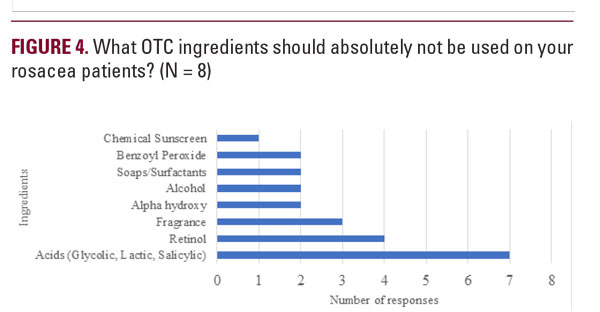inflammatory disorders has been demonstrated following the use of quality skin care.24,26,42 Last, skincare containing mineralizing thermal water has been used to protect the skin against exposome factors causing skin irritation.48
Sunscreen
Sun exposure is a well-known contributory factor to rosacea.1,2,4 Guidelines recommend, and the panel agreed, that sun avoidance and sunscreen with a sun protection factor (SPF) of at least 30 are necessary for rosacea patients.2,6,8,32-35
A moisturizer with an SPF 50+ was shown to be beneficial in adults with rosacea-prone sensitive skin.47 After three weeks of product application, there was a reduced feeling of dryness, itching, and burning of the patients' skin.47 The well-tolerated product was easy to incorporate into the daily skincare regimen.47 Similar results were shown with a tinted daily SPFâ€30 facial moisturizer used for dry skin or as part of the skincare regimen for rosacea patients.46
Survey on OTC skincare
Panelists completed a pre-meeting survey regarding the composition of their rosacea practice, prescribing habits, and OTC skincare recommendations. The goal was to ascertain at what therapeutic junction the OTC products would be recommended, and the important ingredients to be included and omitted in the ideal OTC regimen.
Although the bulk of patients display combination features, patients with pure erythematotelangiectatic, papulopustular, and phymatous rosacea were considered for the sake of the discussion. Respondents indicated that their typical rosacea patient presented with fully erythematotelangiectatic rosacea (30%–40%), fully papulopustular rosacea (30%–60%), and fully phymatous rosacea (5%). For the treatment of fully vascular rosacea, the physicians used laser or a light source (62.5%), oxymetazoline (25%), and brimonidine (12.5%). Treatment of fully inflammatory rosacea included topical medications (87.5%) such as ivermectin 1% cream (50%), azelaic acid (15%) and niacinamide (12,5%), and oral medications (87.5%) including doxycycline (25%) and isotretinoin 0.5 mg/kg (12,5%). Fully phymatous rosacea was treated primarily with procedural methods (50%) and oral isotretinoin (37.5%) (Figure 2). These recommendations are in concordance with published guidelines and treatment
'algorithms.2,4,8,32-3



Sunscreen
Sun exposure is a well-known contributory factor to rosacea.1,2,4 Guidelines recommend, and the panel agreed, that sun avoidance and sunscreen with a sun protection factor (SPF) of at least 30 are necessary for rosacea patients.2,6,8,32-35
A moisturizer with an SPF 50+ was shown to be beneficial in adults with rosacea-prone sensitive skin.47 After three weeks of product application, there was a reduced feeling of dryness, itching, and burning of the patients' skin.47 The well-tolerated product was easy to incorporate into the daily skincare regimen.47 Similar results were shown with a tinted daily SPFâ€30 facial moisturizer used for dry skin or as part of the skincare regimen for rosacea patients.46
Survey on OTC skincare
Panelists completed a pre-meeting survey regarding the composition of their rosacea practice, prescribing habits, and OTC skincare recommendations. The goal was to ascertain at what therapeutic junction the OTC products would be recommended, and the important ingredients to be included and omitted in the ideal OTC regimen.
Although the bulk of patients display combination features, patients with pure erythematotelangiectatic, papulopustular, and phymatous rosacea were considered for the sake of the discussion. Respondents indicated that their typical rosacea patient presented with fully erythematotelangiectatic rosacea (30%–40%), fully papulopustular rosacea (30%–60%), and fully phymatous rosacea (5%). For the treatment of fully vascular rosacea, the physicians used laser or a light source (62.5%), oxymetazoline (25%), and brimonidine (12.5%). Treatment of fully inflammatory rosacea included topical medications (87.5%) such as ivermectin 1% cream (50%), azelaic acid (15%) and niacinamide (12,5%), and oral medications (87.5%) including doxycycline (25%) and isotretinoin 0.5 mg/kg (12,5%). Fully phymatous rosacea was treated primarily with procedural methods (50%) and oral isotretinoin (37.5%) (Figure 2). These recommendations are in concordance with published guidelines and treatment
'algorithms.2,4,8,32-3









